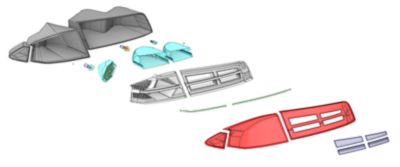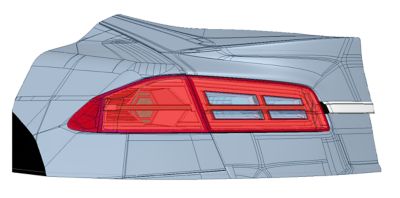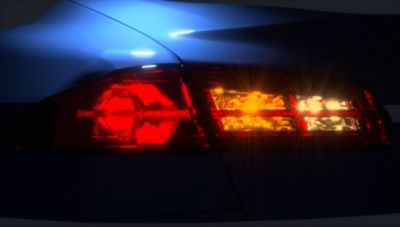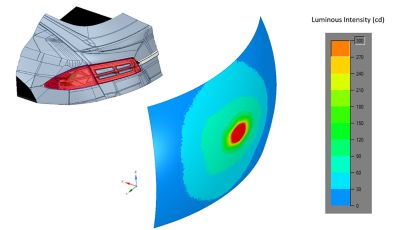-
Ansys is committed to setting today's students up for success, by providing free simulation engineering software to students.
-
Ansys is committed to setting today's students up for success, by providing free simulation engineering software to students.
-
Ansys is committed to setting today's students up for success, by providing free simulation engineering software to students.
-
Contact Us -
Careers -
Students and Academic -
For United States and Canada
+1 844.462.6797
TOPIC DETAILS
Automotive Exterior Lighting: What is it & How Does it Work?
What is Automotive Exterior Lighting?
Automotive exterior lighting focuses on any device around a vehicle's body that uses light, actively or passively, to assist with visibility, navigation, and communication. From headlamps to turn signals, the lights that illuminate the outside of vehicles not only help drivers see, but also help them to be seen.
Exterior car lights are critical to the safe operation of a vehicle, so they’re strictly regulated by government standards that must be fulfilled in order for any light function to be road-legal. These standards cover different factors such as color, intensity, size, placement, and animation.
But in addition to these rigorous requirements, the lights must also meet the approval of an equally discerning audience—the designers. The creative vision of the original equipment manufacturer (OEM) brand must be achieved to deliver the right aesthetic experience to the driver.
What are the Purposes and Functions of Automotive Exterior Lighting?
To balance the need for regulation compliance and artistic integrity, engineers employ several different types of exterior car lights, each serving a different purpose.
Lights to see
Headlamps: The primary lights for illuminating the road ahead, headlamps may use incandescent or halogen bulbs, High Intensity Discharge (HID) sources, LEDs or laser. They can function in either high beam or low beam intensities, as driving conditions and oncoming traffic dictates.
Fog lights: Similar to headlamps, these lights are located on the front of the vehicle and help improve visibility during adverse weather, when regular headlamps may cause glare.
Backup lamps: Used to illuminate the area behind the vehicle when it travels in reverse.
Lights to be seen
Turn signals: Found on the front and back of the vehicle, turn signals indicate the driver’s intention to turn or change lanes. Turn signals can also function as hazard lights, to flash a warning or communicate distress.
Tail lights and stop lights: Located at the back of the vehicle, taillights are responsible for communicating with drivers to the rear. These include brake lights and reverse lights.
Daytime running lights (DRL): Placed at the front of the vehicle, these lights turn on automatically to make the vehicle more visible to other drivers.
License plate illumination: Lights that keep the rear license plate legible at night and in inclement weather so it can be read by authorities, pedestrians, or other drivers.
Side marker lights: Important for larger vehicles, these lights are found on the sides of the vehicle to inform other drivers of the vehicle’s width.
Decorative lighting: Lights such as underbody lights, light carpets, puddle lights and logo illumination not only enhance the vehicle’s appearance but are also helpful in illuminating the ground for safe entrance and exit from the vehicle.
Official service lights: These lights distinguish vehicles that require quick identification as an authorized or emergency vehicle, such as fire trucks, ambulance, school busses, and police.
Designing Automotive Exterior Lighting
To engineer automotive exterior lighting, there are many considerations. First is the designer’s creative vision for the total vehicle. Many car brands have a specific aesthetic they wish to achieve, and lighting schemes are a big component of a vehicle’s appearance. Developing a suite of exterior lights that complements the overall look of the car is essential to delivering an on-brand experience.
Looking at the designer’s concept, engineers take into account the function of the light, the regulations governing it, the space it’s been allotted, and the energy source that powers it. These details will inform their choice of light and its shape, all with consideration of final appearance. Because there’s not one best decision for each light, engineers test and validate their choices using simulation.
Simulation software like Ansys Speos (used to design and validate optical systems) and Ansys AVxcelerate (used for dynamic real-time scenario simulation) lets engineers create virtual models showing how different automotive lighting system configurations will perform in various scenarios and conditions. These simulations account for human vision, determining the visibility of information according to a human observer. Also, a digital rendering of the automotive exterior lighting options can give designers the chance to see how different functional choices will affect the overall aesthetic of their car design.
Example: The development process of an automotive lamp
Here we see how a rear lamp goes from design to engineering.

Rear lamp assembly parts

Rear lamp in vehicle

Speos Virtual Human Vision rendering of a rear lamp showing the tail, stop, turn, and backup light functions activated.

Photometric simulation of the stop light function
Future Trends in Automotive Exterior Lighting
The future of automotive exterior lighting will see advances in both the short and long term. One emerging innovation that will likely become the standard is adaptive headlights, which can automatically adjust their direction and intensity based on driving conditions. Adaptive driving beams (ADBs) use sensors and cameras to collect data on speed and steering, then project light right where the driver needs it.
A little further down the road, exterior car lighting will likely evolve to become an even more valuable communication tool, by using lights as a visual language between vehicles and their environment. Exterior car lights will be able to project speed and direction information, or even create an entire crosswalk for pedestrians. This implementation of Vehicle-to-everything (V2X), will be especially helpful in interactions with autonomous cars.
Machine learning will also be influential in optical design for cars. By looking at all of the exterior lighting design data to date, machine learning will assess what works, what doesn’t, and what’s possible, to accelerate decision making and put safer cars on the road faster.
These trends reflect the flexibility and possibilities within automotive exterior lighting, as it constantly inspires and adapts to the ever-evolving needs of car makers. As regulators, designers, and drivers continue to demand more from the automotive industry, motor vehicle lighting will lead the way towards safer streets.
Related Resources
See What Ansys Can Do For You
See What Ansys Can Do For You
Contact us today
Thank you for reaching out!
We’re here to answer your questions and look forward to speaking with you. A member of our Ansys sales team will contact you shortly.











